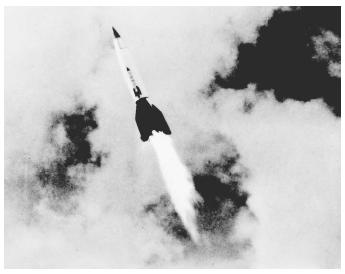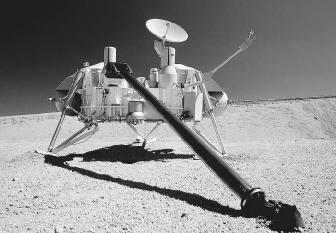Rocketry
The Chinese, in the second century B.C.E. , were the first to make simple rockets that used gunpowder for fuel. These simple rockets were fireworks that were used for religious ceremonies. The idea of fireworks soon took on a military usage. Rocket motors were attached to arrows, to greatly extend their range. The same principles that made the rocket arrows fly has allowed people to go to the moon, launch satellites, fly the space shuttle, and even launch rockets that have bowling balls as nose cones. Rocket launches can be seen at Tripoli Rocketry Association and National Association of Rocketry launches throughout the United States. One can see small rockets as well as rockets taller than 14 feet (4.3 meters) being launched.
Rockets fly because of Newton's Third Law of Motion: for every action there is an equal and opposite reaction. Hot gases are produced from the burning of fuel in the rocket motor. The gases push against the inside of the rocket motor as they expand. The hot gas is forced out of the rocket, creating an action force. This creates a reaction force that moves the rocket in the opposite direction. The same thing happens when the end of an inflated balloon is released: the gas escapes in one direction, and the balloon moves in the opposite one.
Until the twentieth century, rockets were small. They were used for firework displays, weapons, to send life lines to ships at sea, and to send signals. Scientists such as Robert Goddard, Konstantin Eduardovich Tsiolkovsky, Hermann Oberth, and Wernher von Braun developed the science and technology that allowed large rockets to fly. In doing so, they developed the science that allowed human space travel.
Goddard realized the potential of rockets and space flight. His analysis of liquid-fuel rocket motors and rocket motors with adjustable thrust, as well as his analysis that rockets could work in space, allowed for the development of today's large rockets. Goddard holds close to seventy patents in rocketry.
In 1903 Konstantin Eduardovich Tsiolkovsky proposed using liquid propellants in rockets, and in 1929 he proposed using multistage rockets as a means of space travel. Hermann Oberth showed that liquid fuels provide a better source of energy for space flight than solid fuels. He worked with young German engineer von Braun to test liquid-fuel motors. Motors were tested in the early 1930s by tossing lit gasoline-soaked rags under a rocket motor, running for cover, and then opening the valve.
Von Braun started to develop rockets for the German army in 1932. He worked in the secret rocket laboratory in Peenemünde, in northeast Germany. He developed the V2 rocket, which served as a guide to start the space programs in the United States and the Soviet Union. This rocket was about 46 feet (14 meters) long and could carry a 2,200-pound (998-kilogram) payload of explosives at speeds of up to 3,500 miles (5,633 kilometers) per hour. Germany first launched the V2 rocket as a weapon of war at Paris on September 6, 1944, and rocket attacks on Britain followed. At the war's end, in 1945, the United States shipped home 100 V2 rockets along with many of the best rocket scientists from Peenemünde. Most of these rockets were launched for scientific research in White Sands, New Mexico. Von Braun spent fifteen years developing missiles for the United States military. He was transferred to NASA in 1960 with a mandate to develop the Saturn rocket, the rocket that went to the moon with the Apollo program.
The world of rocketry changed dramatically on October 4, 1957. The Soviet Union launched Sputnik to an orbit 340 miles (547 kilometers) high.

The satellite circled Earth, sending back a beeping sound that amazed the world. In 1958 the United States successfully launched the 31-pound (14-kilogram) Explorer satellite into space for the first time.
In 1961 humans first reached outer space, when Soviet cosmonaut Yury Gagarin flew for 60 minutes in Vostok 1 . On May 5, 1961, Alan Shepard Jr. became the first U.S. astronaut to fly in space. Shepard's Project Mercury flight lasted 15 minutes. John Glenn became the first American astronaut to circle Earth, on February 20, 1962.
Project Gemini launched a capsule for two astronauts. Gemini's ten flights provided experiences with space walks, docking, weightless conditions, and spacecraft recovery that made the Apollo missions to the moon possible.
On July 20, 1969, Neil Armstrong and Buzz Aldrin landed on the moon, where they collected soil and rock samples, took pictures, and performed experiments.
In 1973 astronauts first spent long missions in space on Skylab . This space station enabled experimentation and long stays in space. In 1981 Columbia , the first reusable spacecraft, was launched.
Fuels used in the solid-fuel rockets are a mixture of aluminum metal and ammonium perchlorate. This fuel is used to power the space shuttle boosters. It also powers amateur rockets flown at Tripoli Rocketry Association and National Association of Rocketry launches.
Engines on the space shuttle also burn a mixture of hydrogen and oxygen. The hydrogen and oxygen are compressed and cooled to a liquid in the main fuel tank. When they burn to form water, the combustion is so complete that it often does not look like the motor is burning. Liquid-fuel motors may also burn combinations of kerosene and liquid oxygen. Hybrid motors, using a liquid and solid fuel, are used in amateur rocketry. The fuel

is solid cellulose, and the liquid oxidizer is nitrous oxide (N 2 O). The hybrid motors are advantageous, as they have a lower cost per flight than does a solid fuel motor.
NASA's Lewis Research Center is applying new battery technology with space flights. Lithium-ion batteries are flat batteries that are connected in series to obtain the required voltage . They are more efficient and weigh much less than the rechargeable NiCd batteries. They do not use lithium metal and do not require liquid; instead, they use a solid polymer electrode. Even when subjected to high pressure or shorts, the batteries do not explode. Possible spin-off uses include powering cell phones, laptop computers, and electric vehicles.
SEE ALSO New Battery Technology .
Bill Bertoldi
Bibliography
Alway, Peter (1996). Retro Rockets: Experimental Rockets 1926–1941. Ann Arbor, MI: Saturn Press.
Alway, Peter (1999). Rockets of the World, 3rd edition. Ann Arbor, MI: Saturn Press.
Alway, Peter (2000). In the Shadow of the V-2: 15 Historical Rockets Derived from or Resembling the V-2. Ann Arbor, MI: Saturn Press.
Canepa, Mark (2002). Modern High-Power Rocketry: An Illustrated How-To Guide. Victoria, BC: Trafford.
Chaikin, Andrew (2002). Space: A History of Space Exploration in Photographs. London: Carlton Books.
Engelmann, Joachim (1990). V2: Dawn of the Rocket Age. West Chester, PA: Schiffer.
Furniss, Tim (2001). The History of Space Vehicles. San Diego, CA: Thunder Bay Press.
Launius, Roger D., and Ulrich, Bertram (1998). NASA & the Exploration of Space: With Works from the NASA Art Collection. New York: Stewart, Tabori & Chang.
Stine, G. Harry (1994). Handbook of Model Rocketry, 6th edition. New York: Wiley.
Internet Resources
National Association of Rocketry. Available from http://www.nar.org .
Tripoli Rocketry Association. Available from http://www.tripoli.org .
Comment about this article, ask questions, or add new information about this topic: